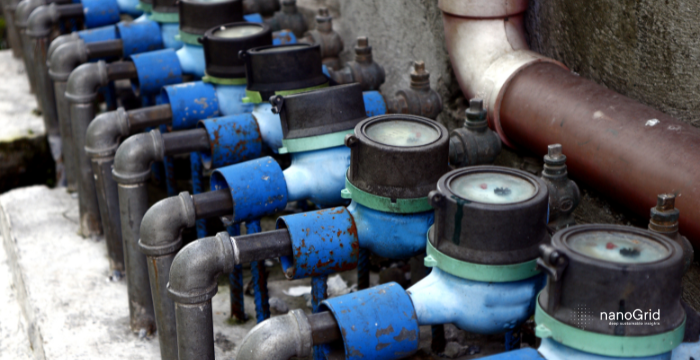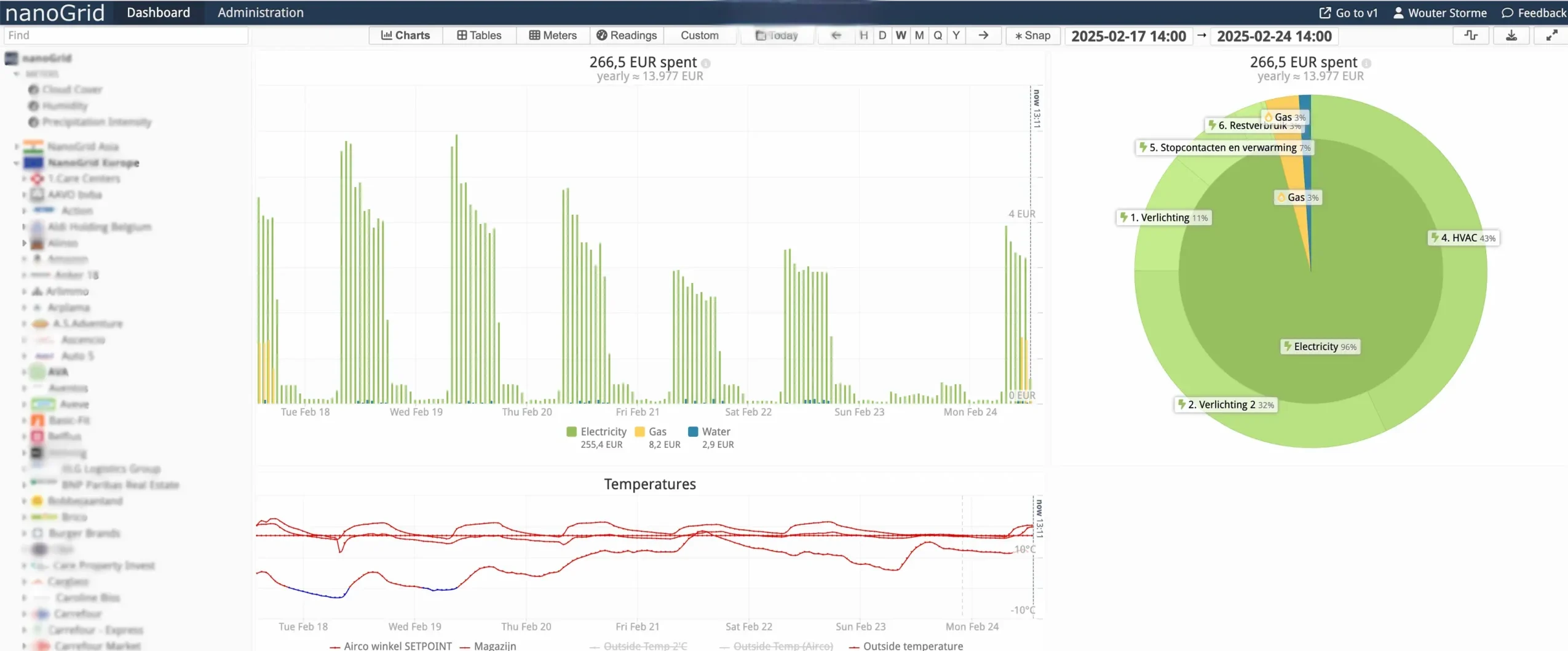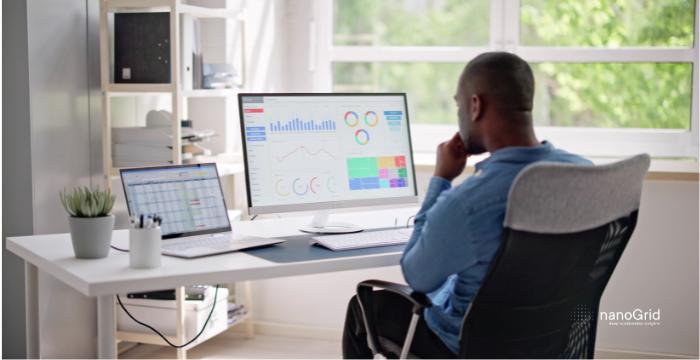Managing energy costs and achieving sustainability goals are pressing concerns for enterprises, especially those operating multiple locations. However, traditional metering systems provide only high-level consumption data, lacking the needed granularity to pinpoint inefficiencies and optimize energy use. This is where submetering becomes essential. By enabling real-time monitoring of electricity, water, gas, and other utilities at tenant, department, or equipment level. In short, submetering empowers businesses to:
- Improve energy efficiency by identifying and eliminating waste.
- Ensure ESG & CSRD compliance through precise sustainability reporting.
- Optimize costs by tracking and controlling consumption patterns.
- Enhance transparency in tenant billing and operational insights.
In this article, we’ll explore what submetering is, how it works, and why it’s a game-changer for property owners, tenants, and facility managers. And some good insights from our deep expertise in sustainability-driven projects.
How does submetering work?
Submeters are installed after a main utility meter to track energy use in specific areas or for individual tenants. Submeters are generally classified into three types:
- Manual Submetering: Requires periodic manual readings.
- Automated Meter Reading (AMR): Uses sensors to collect usage data at set intervals.
- Advanced Metering Infrastructure (AMI): Provides real-time, two-way data collection, mostly integrated with IoT and cloud-based energy management systems.
Besides this, submetering systems often include data loggers or transmitters that send consumption data to a central monitoring platform for analysis and billing. By leveraging submetering, enterprises gain actionable insights to cut costs, enhance sustainability, and optimize operations. It drives conservation by ensuring tenants pay for their actual usage, while property owners recover utility costs and improve property value. Check out our in-depth article on what is a submeter. Now let’s breakdown some of the top advantages of submetering.
The benefits of submetering for enterprises
Submetering offers a wide range of benefits for enterprises, from cost savings and energy efficiency to compliance and operational optimization. Below, we explore the most impactful advantages and categorize them:
1. Precise cost allocation & billing transparency
Submetering eliminates guesswork in shared utility costs, ensuring transparent, real–time billing. Businesses can fairly distribute expenses, prevent disputes, and ensure each tenant or department pays only for what they use. Submetering allows to track major energy consumers like HVAC and lighting separately, ensuring precise cost allocation. It also identifies wasteful energy patterns in real time, helping businesses spot inefficiencies early and take corrective action before costs rise. Even by using the correct software or service providers you can setup real time alerts.
2. Energy Efficiency & Cost Savings
Energy inefficiencies can drastically increase operational costs, especially in large-scale facilities. Submetering allows companies to gain real-time visibility into their energy consumption and take proactive steps to reduce waste.
Identifies wasteful energy consumption patterns
Submeters provide real-time insights into which areas of a facility consume excessive energy, allowing businesses to eliminate inefficiencies before they escalate.
Helps in load balancing and demand-side management
By analyzing consumption patterns, enterprises can redistribute loads across peak and off-peak hours, which prevents unnecessary fees and cuts total expenses.
Allows real-time alerts for anomalies or excessive consumption
Submeters detect unexpected energy spikes, equipment malfunctions, or inefficient processes, enabling quick corrective actions that prevent costly energy waste.
3. ESG & sustainability compliance
With ESG reporting standards tightening across industries, enterprises must track and report their energy usage accurately. Submetering plays a critical role in meeting Corporate Sustainability Reporting Directive (CSRD) and other regulatory requirements.
Submetering provides accurate data for ESG & CSRD compliance:
It allows companies to quantify their energy usage and emissions with precision, ensuring accurate reporting.
How submetering influences the BREEAM score
Submetering aligns with BREEAM’s focus on operational energy management and resource efficiency, earning credits in categories like Energy and Water. Beyond sustainability, submetering improves transparency and accountability, making it a smart strategy for optimizing environmental performance. (Source: The BREEAM Knowledge Base, the credit ENE 02 – Energy Monitoring specifically addresses submetering).
Track and reduce Scope 1 & Scope 2 emissions
Enterprises can identify areas where carbon emissions can be reduced, supporting their long term net-zero strategies.
Benchmark against industry standards
With submetering, enterprises can compare energy performance across different locations, departments, or equipment. Making it easier to identify inefficiencies and meet sustainability (global) targets.
4. Operational insights & asset management
Beyond cost savings and compliance, submetering improves operational efficiency by identifying inefficiencies in equipment and processes.
Identify faulty or inefficient equipment
For example, if an HVAC system or machine consumes more energy than expected, submetering pinpoints the issue before it drives up costs. The level of detail depends on the submeter’s granularity.
Submetering enables easy benchmarking
On the other hand submetering enables benchmarking across sites, departments, or even production lines, revealing inefficiencies and energy-saving opportunities. This real-time, data-driven approach enables businesses to adapt operations on the fly, cutting waste and boosting efficiency. In just a few moments.
Assists in predictive maintenance, reducing costly downtime
By tracking equipment performance over time, businesses can schedule proactive maintenance, preventing unexpected failures.
Provides granular control over operational efficiency
With detailed insights into which areas of a facility consume the most energy, enterprises can optimize workflows, adjust settings, and improve overall efficiency.
Submetering combined with metadata: next level optimization
In our opinion, is understanding the link between submetering and metadata is essential. Submetering does more than track energy, it unlocks metadata-driven insights that refines cost strategies, optimize operations, and enhance ESG reporting. By integrating real-time data with metadata, businesses gain deeper insights into, for example, CO₂ emissions, air quality, and benchmarking, enabling better governance, cost control, and sustainability. Enterprises can track Scope 1 & 2 emissions, optimize HVAC performance, and enhance workplace safety. Some clients of our leverage metadata-powered submetering to benchmark energy costs, predict demand, and refine procurement strategies. Outdoor meter data adds another layer, using weather insights and predictive maintenance to further optimize energy use. For businesses prioritizing ESG, metadata-driven submetering simplifies compliance, strengthens ratings, and ensures decisions are backed by accurate data. It’s no longer optional, it’s essential for future-proofing operations and sustainability.
Types of submeter solutions
Different submeter solutions track various utilities, from electricity and gas to smart IoT-enabled systems. Choosing the right one helps enterprises monitor consumption, cut costs, and optimize operations. Let’s explore the most widely used submetering solutions and their impact on energy management.
Electrical submetering
As we all know, electricity is one of the largets operational costs for enterprises. That makes electrical submetering keen for boosting energy efficiency. Submeters track energy use at the tenant, department, or equipment level. One major advantage of electrical submetering is peak demand management. Energy costs spike during peak hours, and without detailed data, businesses struggle to adjust usage. Submetering provides real-time insights, helping companies shift non-essential loads to off-peak times. This reduces demand charges and lowers electricity costs. Moreover, electrical submetering helps facility managers track power quality. It detects voltage drops, fluctuations, and inefficiencies, revealing underperforming equipment. This allows for predictive maintenance, preventing minor issues from turning into costly failures. 
Water submetering
Responsible water management is a top growing concern. Especially in regions with stricter water conservation laws. Water submetering provides real-time insights into consumption at the tenant, department, or even appliance level. A key benefit is early leak detection. Even a small, unnoticed leak can waste thousands of liters, driving up costs and harming the environment. Submeters can track consumption patterns, and again flagging leaks or excessive use in real time. For multi-tenant buildings, fair water billing is another major advantage. Instead of splitting costs equally, submetering charges tenants based on actual consumption. This ensures transparency and promotes responsible water use.
Gas & thermal submetering
For enterprises relying on gas-powered heating systems, HVAC, or industrial thermal processes, submetering is an essential tool for optimizing efficiency. Gas submetering tracks fuel usage for heating systems, production processes, and district heating networks, ensuring that consumption remains efficient and cost-effective. Gas submetering is essential for industrial facilities that rely on steam generation, compressed air, or process heating. These energy-intensive systems can drive up costs if inefficient. Luckily, submeters track heating performance, detect waste, and help businesses fine-tune operations in real time. For HVAC systems, thermal submetering can optimize heating and cooling loads, preventing energy waste and unnecessary emissions. It also supports CSRD and ESG compliance, as companies need precise tracking of Scope 1 emissions (direct fuel use) to meet sustainability goals.
IoT-enabled smart submetering
In our opinion, the future of submetering lies in IoT-driven solutions, where real-time data meets cloud-based analytics for smarter energy management. Smart submeters go beyond monitoring, they enable predictive maintenance, automated optimization, and full data visibility across multiple locations. With IoT-enabled submeters, companies can track usage remotely, benchmark performance, and optimize settings in real time, just as we at nanoGrid do, down to the minute. And normally it’s all visualised in one beatiful dashboard. For ESG and CSRD compliance, IoT submeters automate sustainability reporting, providing accurate, up-to-date energy data without relying on manual tracking or third party providers.
Submetering: The smart way to cut costs, boost efficiency, and stay compliant
Submetering isn’t just about measuring energy, it’s about making the data your own. By unlocking real-time insights, companies can eliminate unecessary waste. And stay ahead of evolving ESG and CSRD regulations. Whether you’re a property owner looking for fair tenant billing, a facility manager aiming to cut inefficiencies, and boost sustainability.
Submetering provides the granularity you need to make smarter decisions. But the real game-changer? Metadata combined with submetering. By integrating detailed utility data with predictive analytics, businesses can refine procurement strategies, optimize HVAC loads, and turn energy data into a competitive advantage. 
At nanoGrid, we make submetering work for you – and the planet
At nanoGrid, submetering is at our core, providing unmatched utility data coverage to give enterprises complete visibility into their energy consumption. Unlike grid distributors, who don’t offer submetering because it doesn’t fit their business model. The first step to controlling energy use is understanding it. Our technology enables you to track electricity, gas, water, and gas consumption per minute, storing data securely in the cloud and displaying it in real-time through the nanoGrid app. With 24/7 access across all devices!
By providing granular-level submetering, nanoGrid helps enterprises track, analyze, and manage even the most complex energy flows. This drives cost-effective, data-driven decisions that support both financial performance and sustainability goals.
Our intelligent alert system detects anomalies, allowing companies to prevent waste, cut costs, and optimize efficiency. The future of energy management isn’t just about tracking, it’s about transforming. Ready to take control? Start leveraging submetering today. Interested how we cover almost 100% of your utility data? Contact us and we’ll be in touch right away.




